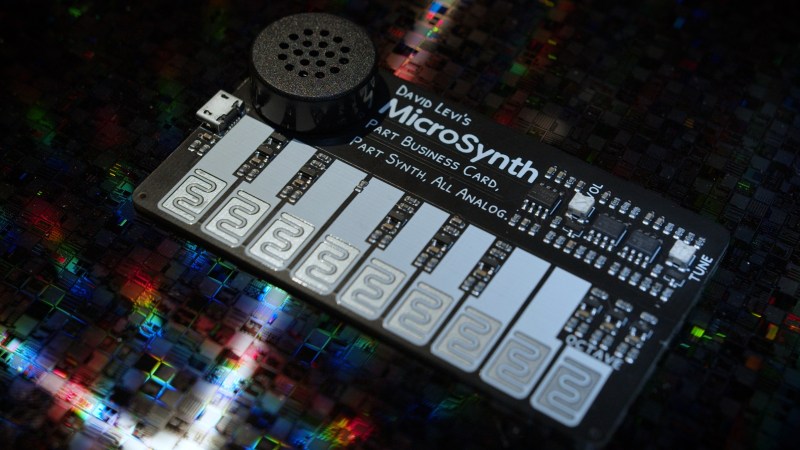While [MicroKits]’ MicroSynth is an all-analog synthesizer that fits on a business card-sized PCB, and he actually does use it to break the ice in business meetings, that’s not really the idea behind this project. Rather, [MicroKits] is keen to get people playing with synths, and what better way than a synth you can build yourself?
There was an ulterior motive behind this project, too: prototyping circuits for a more complete synthesizer. Thus, the design is purposely very simple — no microcontrollers, no logic chips, and not even a 555 to be found. It doesn’t even have buttons; instead, the one-octave keyboard just has interdigitated traces that are bridged by the player’s fingers, forming resistive touchpads. The keyboard interface circuit is clever, too — [MicroKits] uses a pair of op-amps to convert the linear change in resistance across the keyboard to a nearly exponential voltage to drive the synth’s voltage-controlled oscillator (VCO). The video below shows what it can do.
We love projects like these because they show what can be accomplished strictly using analog circuits. We don’t have any problem with other synth designs, mind you — this 555-based dub siren we featured recently was great, too.


















It is beautiful. I wonder how many hours were spent in developing it?
Beautiful indeed!
As for suggestions, feedback looping?
Could a piezo speaker work well enough? (making it thinner- like a business card)
I’ll need to try a piezo! Looping is really tricky unfortunately, it would need a whole digital signal processor. Check out PhonicBloom for tiny digital synths.
ATTiny86 etc ??
Probably overkill but putting some more powerful MCU like a STM32F4 etc on it would be really nice.
Not sure of the cost of all the anlogue components, potentially the BOM cost would not go up that much.
The overall idea has been in my head for a few months, but it took just a week to design the schematic and another week to lay out the board. I actually skipped prototyping in a few areas, and went straight to making the PCB. So I was surprised when everything worked how I wanted, including the volume levels!
“Hang on, I gotta get this melody–er, pitch control, just right…”
I love it. It’s nice showing what analog can do. No black magic with a STM32. Just old school analog.
Plus it’s hard to get your hands on processors right now! One reason I went all analog is because it’s the only thing I can be sure I can source this year.
Can you extend what you did at the end of the video to add a pitch bending feature? That was great!
He’s putting a finger on one or more OP amps’ leads to distort the analog signal. You can see it in the video plus his hint “told you it was analog”. If it were digital the effect wouldn’t be there or at least not to that extent.
Cheers!
Yes exactly. I’m placing my finger on the integrating capacitor on the VCO, so instead of smoothly charging and discharging each pulse it gets noisy!
Does a single VCO really qualify as a “Synth(esizer)” these days? I think it’s just a tone generator. And sorry for the bean counting, but a technical website like this should use technically correct terms – IMHO ;-)
Early analog portables probably had one VCO. Early studio synthesizers might have had more than one VCO, but generally those were one note at a time. An extra VCO might be used as a drone, or at a very low frequency to modulate something else. Having two VCOs is more flexible than a dedicated low frequency oscillator for vibrato or tremelo.
What separates the organs from the synthesizers would be processing. Are there multiple waveforms, is there filtering, is there envelope control? A toy organ would have none of that, a fancy organ would, but not flexible like a synthesizer.